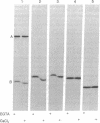Abstract
The inhibitory protein that binds calmodulin and thus prevents activation of several Ca2+-dependent enzymes by calmodulin is shown to also bind four Ca2+ per mol of protein with high affinity (Kd less than or equal to 10(-6) M). On the basis of its Ca2+- binding properties and its localization to nervous tissue, the inhibitory protein is now called "calcineurin." Calcineurin is composed of two subunits: calcineurin A (61,000 Mr) which interacts with calmodulin in a Ca2+-dependent fashion, and calcineurin B (15,000 Mr) which binds Ca2+. The interaction of calcineurin A with calcineurin B is independent of Ca2+ or Mg2+. The dual interaction of calcineurin A with two different Ca2+-binding components and the high affinity of calcineurin for Ca2+ suggest a possible role for calcineurin in the regulation of free Ca2+ concentrations in the nervous system. Calcineurin may thereby modulate the release and action of neurotransmitters.
Full text
PDF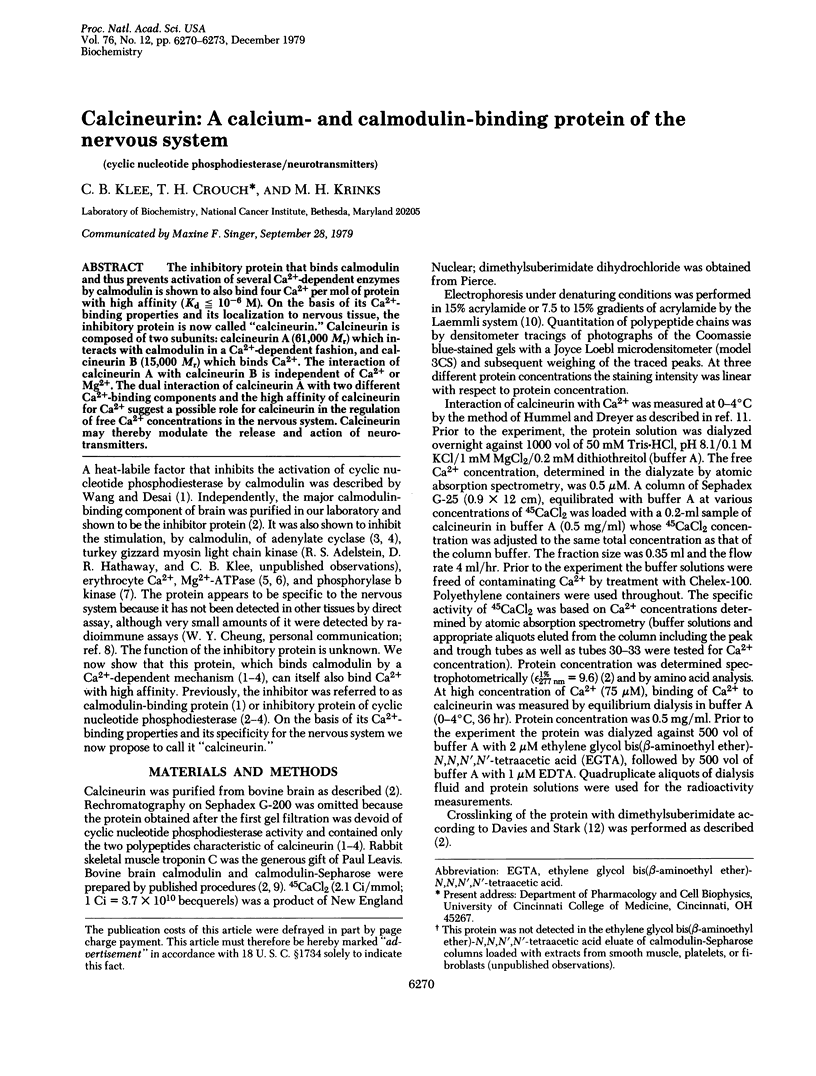
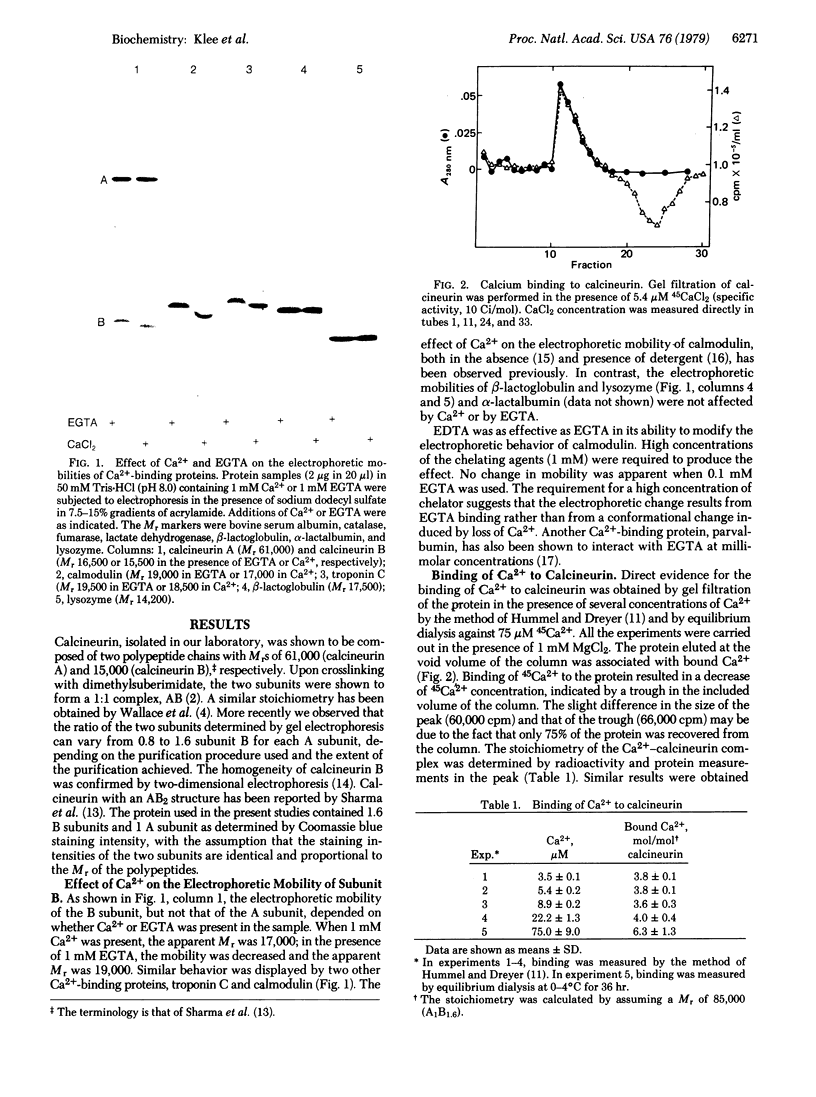
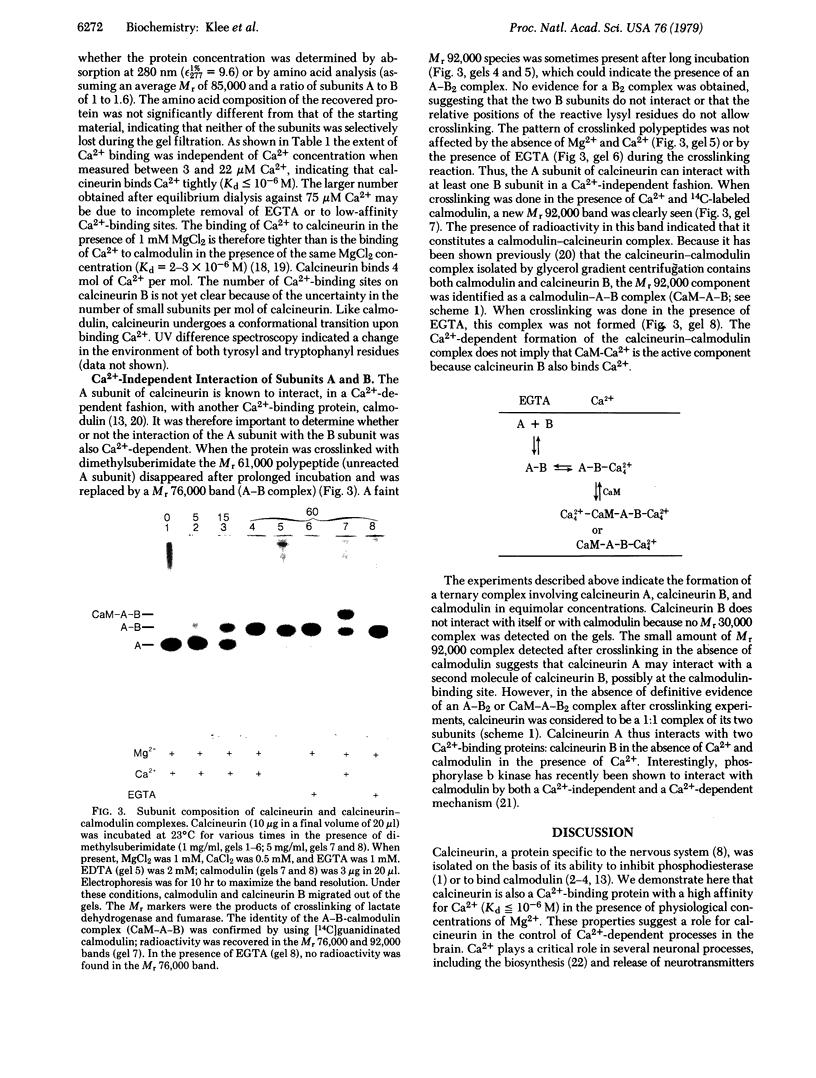
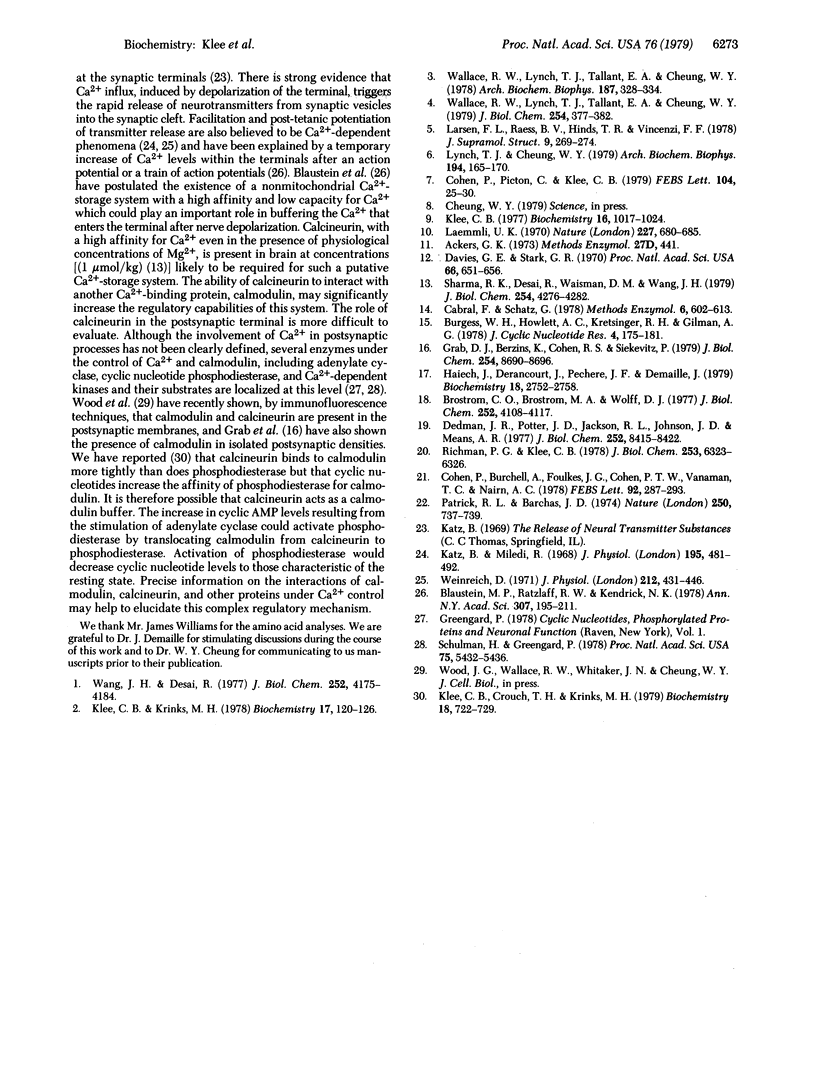
Images in this article
Selected References
These references are in PubMed. This may not be the complete list of references from this article.
- Ackers G. K. Studies of protein ligand binding by gel permeation techniques. Methods Enzymol. 1973;27:441–455. doi: 10.1016/s0076-6879(73)27018-0. [DOI] [PubMed] [Google Scholar]
- Blaustein M. P., Ratzlaff R. W., Kendrick N. K. The regulation of intracellular calcium in presynaptic nerve terminals. Ann N Y Acad Sci. 1978 Apr 28;307:195–212. doi: 10.1111/j.1749-6632.1978.tb41943.x. [DOI] [PubMed] [Google Scholar]
- Burgess W. H., Howlett A. C., Kretsinger R. H., Gilman A. G. S49 lymphoma wild type and variant clones contain normal calcium dependent regulator. J Cyclic Nucleotide Res. 1978 Jun;4(3):175–181. [PubMed] [Google Scholar]
- Cohen P., Burchell A., Foulkes J. G., Cohen P. T., Vanaman T. C., Nairn C. Identification of the Ca2+-dependent modulator protein as the fourth subunit of rabbit skeletal muscle phosphorylase kinase. FEBS Lett. 1978 Aug 15;92(2):287–293. doi: 10.1016/0014-5793(78)80772-8. [DOI] [PubMed] [Google Scholar]
- Cohen P., Picton C., Klee C. B. Activation of phosphorylase kinase from rabbit skeletal muscle by calmodulin and troponin. FEBS Lett. 1979 Aug 1;104(1):25–30. doi: 10.1016/0014-5793(79)81078-9. [DOI] [PubMed] [Google Scholar]
- Davies G. E., Stark G. R. Use of dimethyl suberimidate, a cross-linking reagent, in studying the subunit structure of oligomeric proteins. Proc Natl Acad Sci U S A. 1970 Jul;66(3):651–656. doi: 10.1073/pnas.66.3.651. [DOI] [PMC free article] [PubMed] [Google Scholar]
- Dedman J. R., Potter J. D., Jackson R. L., Johnson J. D., Means A. R. Physicochemical properties of rat testis Ca2+-dependent regulator protein of cyclic nucleotide phosphodiesterase. Relationship of Ca2+-binding, conformational changes, and phosphodiesterase activity. J Biol Chem. 1977 Dec 10;252(23):8415–8422. [PubMed] [Google Scholar]
- Grab D. J., Berzins K., Cohen R. S., Siekevitz P. Presence of calmodulin in postsynaptic densities isolated from canine cerebral cortex. J Biol Chem. 1979 Sep 10;254(17):8690–8696. [PubMed] [Google Scholar]
- Haiech J., Derancourt J., Pechère J. F., Demaille J. G. Magnesium and calcium binding to parvalbumins: evidence for differences between parvalbumins and an explanation of their relaxing function. Biochemistry. 1979 Jun 26;18(13):2752–2758. doi: 10.1021/bi00580a010. [DOI] [PubMed] [Google Scholar]
- Katz B., Miledi R. The role of calcium in neuromuscular facilitation. J Physiol. 1968 Mar;195(2):481–492. doi: 10.1113/jphysiol.1968.sp008469. [DOI] [PMC free article] [PubMed] [Google Scholar]
- Klee C. B. Conformational transition accompanying the binding of Ca2+ to the protein activator of 3',5'-cyclic adenosine monophosphate phosphodiesterase. Biochemistry. 1977 Mar 8;16(5):1017–1024. doi: 10.1021/bi00624a033. [DOI] [PubMed] [Google Scholar]
- Klee C. B., Crouch T. H., Krinks M. H. Subunit structure and catalytic properties of bovine brain Ca2+-dependent cyclic nucleotide phosphodiesterase. Biochemistry. 1979 Feb 20;18(4):722–729. doi: 10.1021/bi00571a026. [DOI] [PubMed] [Google Scholar]
- Klee C. B., Krinks M. H. Purification of cyclic 3',5'-nucleotide phosphodiesterase inhibitory protein by affinity chromatography on activator protein coupled to Sepharose. Biochemistry. 1978 Jan 10;17(1):120–126. doi: 10.1021/bi00594a017. [DOI] [PubMed] [Google Scholar]
- Laemmli U. K. Cleavage of structural proteins during the assembly of the head of bacteriophage T4. Nature. 1970 Aug 15;227(5259):680–685. doi: 10.1038/227680a0. [DOI] [PubMed] [Google Scholar]
- Larsen F. L., Raess B. U., Hinds T. R., Vincenzi F. F. Modulator binding protein antagonizes activation of (Ca2+ + Mg2+)-ATPase and Ca2+ transport of red blood cell membranes. J Supramol Struct. 1978;9(2):269–274. doi: 10.1002/jss.400090211. [DOI] [PubMed] [Google Scholar]
- Lynch T. J., Cheung W. Y. Human erythrocyte Ca2+-Mg2+-ATPase: mechanism of stimulation by Ca2+. Arch Biochem Biophys. 1979 Apr 15;194(1):165–170. doi: 10.1016/0003-9861(79)90606-4. [DOI] [PubMed] [Google Scholar]
- Patrick R. L., Barchas J. D. Stimulation of synaptosomal dopamine synthesis by veratridine. Nature. 1974 Aug 30;250(5469):737–739. doi: 10.1038/250737a0. [DOI] [PubMed] [Google Scholar]
- Richman P. G., Klee C. B. Interaction of 125I-labeled Ca2+-dependent regulator protein with cyclic nucleotide phosphodiesterase and its inhibitory protein. J Biol Chem. 1978 Sep 25;253(18):6323–6326. [PubMed] [Google Scholar]
- Schulman H., Greengard P. Ca2+-dependent protein phosphorylation system in membranes from various tissues, and its activation by "calcium-dependent regulator". Proc Natl Acad Sci U S A. 1978 Nov;75(11):5432–5436. doi: 10.1073/pnas.75.11.5432. [DOI] [PMC free article] [PubMed] [Google Scholar]
- Sharma R. K., Desai R., Waisman D. M., Wang J. H. Purification and subunit structure of bovine brain modulator binding protein. J Biol Chem. 1979 May 25;254(10):4276–4282. [PubMed] [Google Scholar]
- Wallace R. W., Lynch T. J., Tallant E. A., Cheung W. Y. An endogenous inhibitor protein of brain adenylate cyclase and cyclic nucleotide phosphodiesterase. Arch Biochem Biophys. 1978 Apr 30;187(2):328–334. doi: 10.1016/0003-9861(78)90042-5. [DOI] [PubMed] [Google Scholar]
- Wallace R. W., Lynch T. J., Tallant E. A., Cheung W. Y. Purification and characterization of an inhibitor protein of brain adenylate cyclase and cyclic nucleotide phosphodiesterase. J Biol Chem. 1979 Jan 25;254(2):377–382. [PubMed] [Google Scholar]
- Wang J. H., Desai R. Modulator binding protein. Bovine brain protein exhibiting the Ca2+-dependent association with the protein modulator of cyclic nucleotide phosphodiesterase. J Biol Chem. 1977 Jun 25;252(12):4175–4184. [PubMed] [Google Scholar]
- Weinreich D. Ionic mechanism of post-tetanic potentiation at the neuromuscular junction of the frog. J Physiol. 1971 Jan;212(2):431–446. doi: 10.1113/jphysiol.1971.sp009333. [DOI] [PMC free article] [PubMed] [Google Scholar]
- Wolff D. J., Poirier P. G., Brostrom C. O., Brostrom M. A. Divalent cation binding properties of bovine brain Ca2+-dependent regulator protein. J Biol Chem. 1977 Jun 25;252(12):4108–4117. [PubMed] [Google Scholar]



